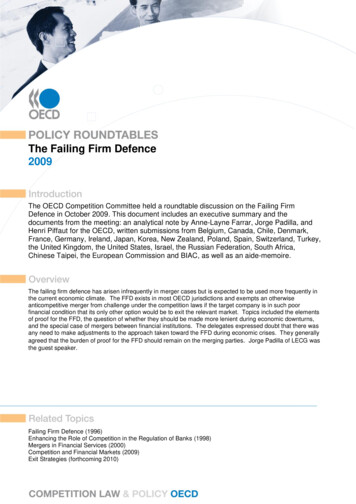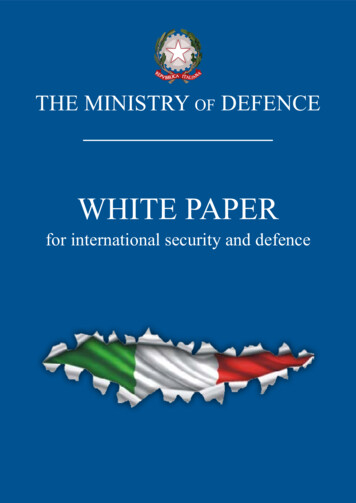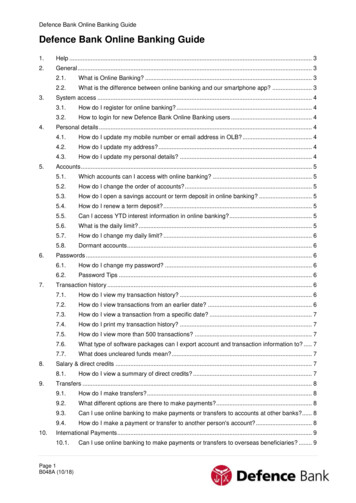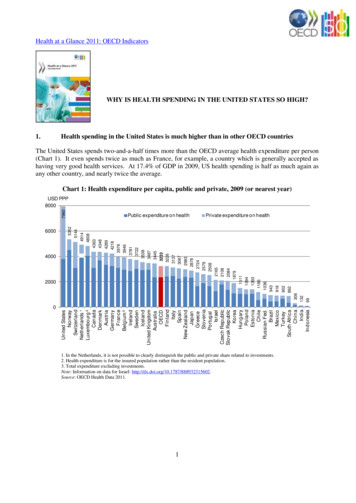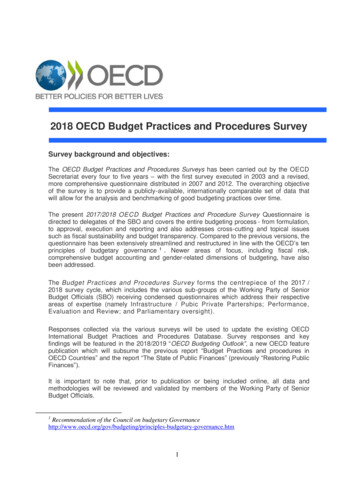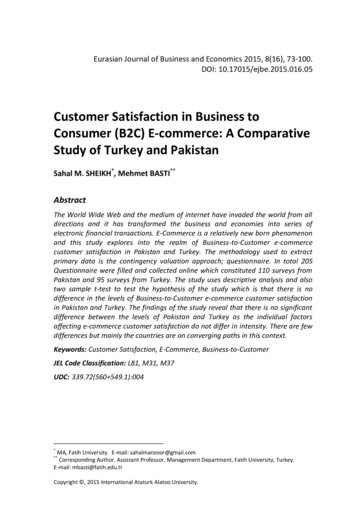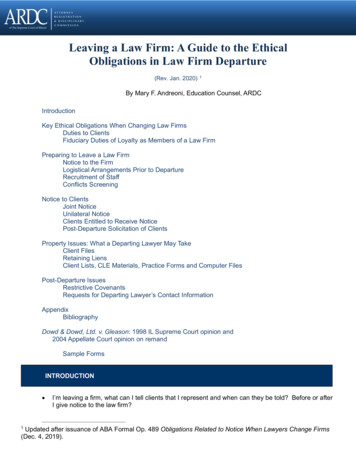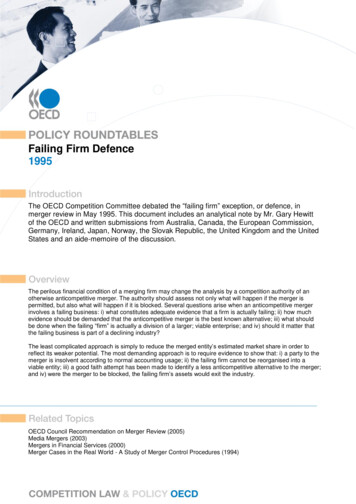
Transcription
Failing Firm Defence1995The OECD Competition Committee debated the “failing firm” exception, or defence, inmerger review in May 1995. This document includes an analytical note by Mr. Gary Hewittof the OECD and written submissions from Australia, Canada, the European Commission,Germany, Ireland, Japan, Norway, the Slovak Republic, the United Kingdom and the UnitedStates and an aide-memoire of the discussion.The perilous financial condition of a merging firm may change the analysis by a competition authority of anotherwise anticompetitive merger. The authority should assess not only what will happen if the merger ispermitted, but also what will happen if it is blocked. Several questions arise when an anticompetitive mergerinvolves a failing business: i) what constitutes adequate evidence that a firm is actually failing; ii) how muchevidence should be demanded that the anticompetitive merger is the best known alternative; iii) what shouldbe done when the failing “firm” is actually a division of a larger; viable enterprise; and iv) should it matter thatthe failing business is part of a declining industry?The least complicated approach is simply to reduce the merged entity’s estimated market share in order toreflect its weaker potential. The most demanding approach is to require evidence to show that: i) a party to themerger is insolvent according to normal accounting usage; ii) the failing firm cannot be reorganised into aviable entity; iii) a good faith attempt has been made to identify a less anticompetitive alternative to the merger;and iv) were the merger to be blocked, the failing firm’s assets would exit the industry.OECD Council Recommendation on Merger Review (2005)Media Mergers (2003)Mergers in Financial Services (2000)Merger Cases in the Real World - A Study of Merger Control Procedures (1994)
General DistributionOCDE/GD(96)23FAILING FIRM DEFENCEORGANISATION FOR ECONOMIC CO-OPERATION AND DEVELOPMENTParis 199629281Document complet disponible sur OLIS dans son format d'origineComplete document available on OLIS in its original format
Copyright OECD, 1996Applications for permission to reproduce or translate all or part of this material should be made to:Head of Publications Service, OECD, 2, rue André-Pascal, 75775 - Paris Cedex 16, France.Les demandes de reproduction ou de traduction doivent être adressées à :M. le Chef du Service des Publications, OCDE, 2 rue André-Pascal, 75775 Paris Cedex 16, France.2
FORWORDThis document groups together, in their original language, the papers relating to a mini-roundtableon the failing firm exception/defence in merger review, held in May 1995 in the course of a meeting of theCompetition Law and Policy Committee. It is published as a general distribution document under theresponsibility of the Secretary General to give a wider hearing to ideas and views related to a difficultcompetition policy issue arising throughout OECD countries.This compilation is one of the first of a new publication series entitled: "Competition PolicyRoundtables".PRÉFACECe document rassemble la documentation relative à une mini-table ronde qui s’est tenue, en mai1995, dans le cadre du Comité du droit et de la politique de la concurrence. Elle porte sur le traitementdifférencié qui est appliqué à l’argument de l’entreprise défaillante selon que celui-ci est utilisé commemoyen de défense dans la procédure de contrôle des concentrations ou fait l’objet d’une exception àl’application du droit de la concurrence.Cette compilation est l’une des premières qui sera diffusée dans la nouvelle série intitulée "Lestables-rondes de la politique de la concurrence".3
TABLE OF CONTENTSFOREWORDAIDE-MEMOIREBACKGROUND NOTE BY THE SECRETARIATNATIONAL CONTRIBUTIONS:AustraliaAustralian Trade Practices Division and the New Zealand Commerce vak RepublicUnited KingdomUnited StatesEuropean Union4
AIDE-MÉMOIRETo organize the initial participation from countries who made written submissions in connectionwith the mini-roundtable, the Chairman introduced a series of issues and called on certain countries forcomment.Definitional IssuesThe first question was what exactly constitutes a failing firm. How bankrupt must it be; howsoon does it have to be likely to fail; and what are the criteria that one can use to establish that there is afailing as opposed to a "flailing" firm.Canada was asked for its views on these issues in the context of the computerized airlinereservation case featured in its written submission. Canada responded by first pointing out that it has nofailing firm defence as such. Instead, the fact that one of the parties is failing or is likely to fail is astatutorily mandated consideration in making the assessment about the risk a merger poses for competition.Canada proceeded to note that in no case to date was the failing factor determinative.On the issue of what constitutes a failing firm, the Canadian Bureau of Competition Policy usesa likely failure approach (see Canada’s written submission for an itemized list of factors considered). Itamounts to an accounting insolvency test. The Bureau typically retains third party auditors to review thecompany’s books. Canada explained that it does not regard a firm as failing merely because it is notmaking what its management considers to be an adequate rate of return. This was an important factor inthe computerized airline reservation case covered in the submission.The Chairman noted that in the Norwegian submission’s brewery case, it was critical to decidewhether or not a probable inability to recoup in the long run the high costs of a modernization investmentamounted to a firm being in the failing category. He then called on Norway for further elaboration.Norway noted that its failing firm defence requires a high probability that absent the merger, the firm willleave the market. The first task then is to assess whether the firm is really failing. In the brewery case,the target company’s own financial statements revealed that there were merely transitory difficulties. Therewas also evidence that the firm could readily have expanded production using its modern productionfacilities and strong brand names. In addition there were two probable alternative purchasers which wouldhave posed less danger for competition. It was irrelevant to the analysis that they would likely have offereda considerably lower price for the failing firm.The Norwegian Price Directorate’s recommendation to oppose the brewery merger was notfollowed by the Price Council, partly because the majority on the Council felt that the merger target wouldnot have been able to survive in the long run as an independent agent. Interestingly, such reasoning runscounter to the latest guidelines issued by the Price Directorate which specify that only short termconsiderations should be taken into account in determining the applicability of the failing firm doctrine.Long term survivability is believed to be too hypothetical to properly assess.Norway hypothesized that the Price Council may have considered the target firm to be toofinancially weak to compete vigorously. The Price Directorate would have disagreed with that view in thiscase. Speaking more generally however, if the Price Directorate were to wrongly conclude that a firm werefailing when in fact it was only flailing, such an error would not be overly serious. An almost failing firmmay not be an important competitor in the future.5
What criteria must be satisfied for the failing firm defence to be admissible?Many countries apply the failing firm defence only if it can be shown that there are no alternativeless anticompetitive mergers. Some go further and require evidence that if the merger were prohibited, theassets of the failing firm would leave the market. The Chairman wanted to delve into these issues andcalled on Australia to explain the Australian/New Zealand position.Australia stated that merger review in that country and in New Zealand begins by consideringwhether a merger is likely to have anticompetitive effects. It is presumed that there are no such effectswhen the probable consequence of prohibiting a merger would be commercial failure of the target firm withthe result that its productive resources are likely to exit the market. The latter element was not satisfiedin the Waikato dairy case (see the combined Australian/New Zealand written submission). Whereanticompetitive effects are expected, a merger may nonetheless be permitted on wider public benefitgrounds including considerations arising out of one of the party’s financial health.Australia then turned to the newspaper case outlined in its written submission. In that case it wasargued that if the merger were permitted, efficiency gains would have been made and jobs preserved. TheTrade Practices Commission took the view that the merger was anticompetitive because the underlyingpurpose was to prevent a new entrant from gaining the assets and becoming a more effective competitorfor the morning newspaper. In addition it was believed that there was an alternative less anticompetitivepurchaser waiting in the wings. The merger was blocked but unfortunately, no one else purchased the firmand the newspaper went out of business.[Later in the general discussion, the European Commission returned to this case and stated thatthe actual result may have been better than allowing the merger, because the market would be morecontestable with one newspaper compared with two under common ownership.]The Chairman noted that certain countries go beyond requiring evidence that absent the mergerthe productive assets will exit the industry. Both Germany and the European Commission for exampleappear to require evidence that with or without the merger the market shares would accrue to the proposedacquirer. That condition seems to imply that the defence is more easily granted in cases where theacquiring firm enjoys a dominant position than if the market could be characterized as an oligopoly. TheChairman called on Germany to describe the Schott Glaswerke Mainz merger case (see the writtensubmission), and to speculate on how the result might have been different had the buying firm not enjoyeda dominant position.Germany stated that successful application of its failing company defence requires breaking thecausal link between a proposed merger and the creation or strengthening of a dominant position. Absentsuch a causal link, a merger cannot lawfully be prohibited. Thus, if the same anticompetitive effect wouldoccur with or without the merger, as when market shares will be the same in both instances, the necessarycausal link is missing.Two examples were given, both assuming that there were no preferred alternative purchasers:1. two competitors, one of which is failing and proposing to merge with the other - since thesurviving firm is slated to gain the entire market in any event, the merger cannot be prohibited(see the Schott Glasswerke case); and2. several competitors, one of which is failing and proposing to merger with an incumbent firm- a serious investigation is required to determine who would get the market share if the failingfirm exits.6
The Chairman noted that the application of the German failing firm doctrine would seem to beaffected by whether or not a jurisdiction adopts a concept of collective rather than merely single firmdominance. In response Germany stated that there is no clear policy on this point. Each oligopoly situationmust be analyzed on its own to determine whether the redistribution of market shares consequent on theexit of a failing firm would strengthen or weaken the oligopoly.The Chairman turned next to the Japanese submission. He noted that in contrast to the Germanapproach, the merger of a failing firm with a dominant producer might pose more difficulty than the samemerger not involving a dominant producer.Japan stated that the fact a firm is failing is one factor that its Fair Trade Commission (JFTC)considers in judging whether or not the merger may substantially restrain competition in the relevantmarket. Since a failing firm has likely not been performing well for some time, the acquiring firm willsuffer somewhat by taking it over. At the same time however it is believed that there is a greaterprobability of competitive harm if the acquiring firm is an influential firm. Reference was made to one ofthe bank merger examples in the Japanese written submission. The new bank would have had about 30%of the market share measured in terms of deposits and 40% in terms of loans. The purpose of the mergerwas to rescue the failing bank. It was difficult to find a more appropriate purchaser and measures weretaken to reduce competition problems in certain localized markets. Taken together these considerations ledthe JFTC to conclude that the merger would not substantially restrain competition.The Chairman turned next to the economic considerations undergirding the failing firm defenceand asked whether the review criteria are substantially the same or somehow looser when one of the partiesis failing. He invited the United States to respond.The United States (Department of Justice) referred to the 1992 combined DOJ/FTC mergerguidelines and posed the question - since a merger to monopoly is the classic kind of merger that wouldnormally be prohibited, why are such monopolies suddenly acceptable if one of the parties is failing? Atthe beginning of the guidelines, some specific cases of imminent failure are identified as situations wherea merger is not likely to ".create or enhance market power or to facilitate its exercise". In such situations,post merger market performance might be no worse than it would have been had the merger been blockedand the assets exited the industry. So as with Germany, there is a causation factor featured here. Thespecific criteria were then reviewed - and the United States especially highlighted the importance of thefirm being unable to reorganize and there being no alternative less anticompetitive purchaser. The lastfactor, exiting assets, illustrates some of the underlying economic rationale.Two types of assets should be distinguished: those which are specialized to the industry, andthose relatively unspecialized. If the transaction is blocked and the firm fails, specialized assets will simplybe lost from an economic point of view. Where the assets are unspecialized they could be put to aproductive use elsewhere so there would be a need to perform some kind of balancing by comparing howthey will be used with or without the merger. As a practical matter, such a balancing is not actually done,i.e. if it can be shown that there is absolutely no other purchaser and the failing firm cannot reorganize,then the merger is permitted.The United States (Federal Trade Commission) continued by offering what it termed a possiblyslightly controversial view of how things might develop in the future. It referred to an increasing numberof instances where failing/flailing firms or entire industries are associated with growing global competition,surging imports, falling outputs and rising unit costs. In the future, the U.S. and other countries may wantto ensure that capacity is retired and firms exit in a way that enhances an industry’s ability to globallycompete. That would lead to a slightly different and perhaps more generous interpretation of a failing orflailing firm defence, one that takes into account industry-wide distress.7
The Chairman turned to the United Kingdom and asked whether it took a looser approach tomergers if they involved a failing firm. The United Kingdom noted that its competition law does notprohibit mergers of any sort and does not have a notification system. In practice U.K. authorities are muchless concerned about whether a firm is failing or flailing, but instead focus on the underlying causes of thefinancial distress. A merger involving a failing firm would probably be opposed if it were likely to createa dominant position and if a more competitive outcome might well result by letting the firm fail.Asked to elaborate on his query to the United Kingdom, the Chairman stated that it was intendedto be an open question including whether non-competition factors were taken into account in such cases,things like effects on employment or innovation.The United Kingdom responded that it applies a public interest test primarily featuring but notrestricted to competition effects. In recent practice, employment factors have not featured prominently butthat could change. R & D factors are part of the competition analysis. Strategic considerations also applyin certain industries, notably defence where the peace dividend is showing up as a contraction in the marketand increased concentration. In sum, cases taking account of non-competition factors are probably veryrare but they could exist.The next issue the Chairman turned to had to do with whether or not countries took account ofthe intentions of an acquiring firm when assessing a merger involving a failing firm. He called on Irelandto comment on this issue from the perspective of the Irish Distillers/Cooley (IDC) merger described in itswritten submission.Ireland stated that the IDC merger was the first one which the Irish competition authorityattempted to block using the competition statute. The case clearly involved a failing firm. A key rationalein the failing firm defence is that absent the merger the assets would leave the market causing a greater lossof welfare than would occur if the merger were permitted. The competition authority interpreted this asrequiring that the merger would lead to the assets being retained in the market. The acquirer’s intentionin the IDC case to close down the production capacity therefore nullified the applicability of the defence.Moreover, a price substantially above liquidation value indicated that the acquirer believed there was analternative buyer. Ireland noted that the Secretariat paper argued that the loss of assets is only significantin cases where they will not easily be replaced. That in fact was true in the IDC case.Does the failing firm defence apply as well to failing divisions?The Chairman’s last discussion point dealt with whether or not the failing firm defence shouldbe modified according to whether or not the failing firm is independent or forms part of a larger entity.He called on the European Commission to explain what he thought was a lower willingness to accept thedefence in cases where the failing entity is part of a larger firm.The European Commission noted that given the absence of an express legal provision, its approachto the failing firm defence is based on an interpretation of the general test, i.e. whether or not a mergercreates or strengthens a dominant position. A failing firm defence is permitted in rare cases where theexpected deterioration in the competitive environment would have happened with or without the merger,i.e. there is no causation between the merger and the feared deterioration. Though the test is formally thesame for failing firms and failing divisions, the latter case calls for investigating possible strategic reasonsat the group level for keeping the entity afloat were the merger to be blocked. In the Aérospatiale deHavilland case covered in the written submission, it was not necessary to get into such evidence becauseother required elements were not satisfied.8
General DiscussionAt this point, the Chairman opened the mini-roundtable to general discussion, and Italy wasrecognized. Italy noted that in the European Union’s Kali and Salz case, Goldman Sachs had been assignedthe task of inviting tenders. The Commission therefore had a list of alternative buyers it could investigateto determine if any constituted a less anticompetitive merger partner. Where such information is lacking,how do competition authorities satisfy themselves that there are no less anticompetitive potentialpurchasers? How widely do they search?Canada volunteered that it insisted on an independent shop by an investment broker or similarcompany. Only in this way will the competition agency have the requisite confidence in the shop and beable to live with the result. Tangentially Canada noted that the shop must be recent and be conducted atthe parties’ expense.On the matter of requiring a fresh search, the Chairman asked whether the canvassed buyers areaware of the circumstances behind the search, and if they are, does that affect their bids. Canada said thatthis differs from case to case. In any event the firm’s poor financial health will soon be known to anyserious purchaser. The really strategic information is the identity of the purchaser proposing the mergerunder investigation.Later in the discussion, the United Kingdom returned to the issue of identifying alternative buyers.The U.K. was especially concerned about confidentiality problems (share price and labour force issues) andthe need for speed. In the light of these difficulties, the United Kingdom believed the Canadian paper setout a very demanding process and invited comment on the confidentiality issue.Canada acknowledged the potentially serious confidentiality issues, but noted that in the fourinstances where a shop had been required, the financial ill-health of the affected firm was well known inthe market. In one case where there were grave customer loyalty concerns, the Bureau stuck to the shoprequirement and the failing firm quietly found an alternative, less anticompetitive purchaser.The United Kingdom asked if Canada could envisage a situation where the Bureau of CompetitionPolicy would not insist on a full financial analysis or shop. The answer noted that the financial analysiswas usually an internal matter. As to the shop requirement, there was a case where an eight month oldshop was deemed acceptable because of a desire to avoid an adverse reaction by creditors.Also later in the discussion, Germany addressed the issue of identifying potential buyers and notedthat the net must be cast beyond national boundaries. This applies as well to estimating who would receivemarket share in the event the merger is blocked and the firm allowed to fail.France stated that it would soon distribute a text relating to the failing firm issue. France has notyet had to grapple with this in an actual case. French merger law does not provide for special treatmentfor a failing firm. Firms in perilous financial condition are instead dealt with before specializedcommercial tribunals which can take competition concerns into account. The two step procedure beginswith an opinion from the Competition Council based on a balance of anticompetitive effects and off-settingcontributions to economic progress. Of course there is only a problem where there are in fact competitionconcerns. Considered among contributions to economic progress are things like the maintenance of existingassets, distribution networks, and the current level of exports. The second step, taken by the Ministry ofEconomy which makes the final decision, involves considering a broader social balance. Taken together,the economic and social balancing certainly take account of a firm being in serious financial difficulty.To assess the seriousness of the firm’s financial condition a number of factors are consideredincluding over-capacity problems and business cycle indicators. If the difficulties are judged to be cyclicalin nature they are not taken into account. The existence of possible alternative purchasers is also9
considered, i.e. the alleged anticompetitive effects of the merger may be avoidable. The most difficult issueis to determine whether or not without the merger, the enterprise or a division thereof, would disappearfrom the market. If there would be such an exit, it cannot be said that the merger hurts competition, henceit should be permitted.In the case of a merger to monopoly, can one authorize it? That requires a look at other thingsthe state could do to limit the transaction’s anticompetitive effects. In less difficult cases, where severalfirms will remain, it is necessary to consider how the market share released by the failing firm will bereapportioned.Sweden asked whether there were important differences in treatment accorded to goods producingor service sector mergers involving failing firms. The United States noted that the treatment would be thesame in both sectors, but there are fewer instances of the failing firm doctrine being applied in servicesector mergers. This is because service sector mergers are simply less likely to threaten significantanticompetitive effects, hence defences of all kinds would not often be needed. The U.S. remarked howeverthat in service sectors it will usually be difficult to satisfy the failing firm defence, because absent themerger, the pertinent assets would not likely exit the market, i.e. they are readily re-deployable within thecurrent market.The Chairman turned to Canada to discuss Sweden’s question in the context of Canada’s airlinereservation case. Canada reminded participants that in the case in question, the defence was not applicablebecause the firm was not found to be failing. Canada also agreed with the United States that in serviceindustries, assets are typically more re-deployable than in goods producing sectors.After stating that all countries appeared to use a narrowly crafted failing firm defence, the UnitedStates noted that there were some interesting differences in approach. For instance, some jurisdictions, notincluding the U.S., require that absent the merger the market share would go in any case to the acquiringfirm. This element would easily be satisfied in a case for example, where an acquiring firm has 70% ofthe market and the failing firm the other 30%. Now consider an alternative scenario where the buyer againhas 70% but the other 30% is evenly split among three rivals one of which was failing. In this case, thedefence might be refused, even if the other two smaller rivals did not constitute alternative buyers.Germany admitted that requiring evidence that with or without a merger, market shares would beroughly the same presents some difficult problems requiring a careful practical approach. It is also onereason why there have been few applications of the defence in Germany.Japan returned to the Chairman’s question about how failing firm mergers are essentially differentfrom all other mergers. In Japan, explicit attention is given to the true worth of the assets being acquired.Since the firm is failing it has certain "negative" assets, e.g. poor management. Where a failing firm isbeing acquired by a non-dominant firm, the merger likely has no anticompetitive effects.The Chairman closed the session by thanking all concerned and noting that though we had notgotten to the bottom of this question we had made a good start.10
AIDE-MÉMOIREAfin d’organiser dans un premier temps la participation des pays ayant remis des notes écrites enliaison avec la mini-table ronde, le Président a présenté une série de questions et demandé à certains paysde faire part de leurs commentaires.Problèmes de définitionLa première question a porté sur la définition exacte d’une entreprise défaillante : quelle doit êtrel’ampleur de sa faillite, quelle doit être la proximité de sa défaillance probable et quels sont les critères qu’ilest possible d’utiliser pour établir que l’on se trouve bien en présence d’une entreprise "défaillante" et nond’une entreprise en récession.Le Canada a été invité à présenter son opinion sur ces questions dans le contexte de l’affaire dusystème informatique de réservation de billets d’avion exposée dans sa note. Le Canada a répondu ensoulignant tout d’abord qu’il n’existait pas dans ce pays de défense reprenant l’argument de l’entreprisedéfaillante en tant que telle. En réalité, le fait que l’une des parties soit défaillante ou sur le point de l’êtreconstitue un élément qui doit obligatoirement être pris en considération lors de l’évaluation des menacesqu’une fusion fait peser sur la concurrence. Le Canada a fait remarquer qu’à ce jour, le facteur "défaillance"n’avait été déterminant dans aucune affaire.Sur la question de la définition d’une entreprise défaillante, le Bureau canadien de la politique dela concurrence utilise l’approche de la défaillance probable (voir dans la note du Canada pour la liste desfacteurs pris en compte). Cela revient en fait à une vérification comptable d’insolvabilité. En général, leBureau fait appel à des réviseurs tiers qui examinent les comptes de la société. Le Canada a expliqué qu’ilne considère pas qu’une entreprise est défaillante uniquement parce qu’elle ne parvient pas à réaliser ce quesa direction estime être un taux de rendement approprié. Ce facteur a joué un rôle important dans l’affairede réservation aérienne informatisée exposée dans la note.Le Président a noté que dans l’affaire des brasseries citée par la Norvège, il avait été capital dedécider si la probable incapacité à récupérer à long terme les coûts élevés d’un investissement demodernisation permettait ou non de qualifier une entreprise de "défaillante". Il a ensuite demandé à laNorvège des explications complémentaires. La Norvège a précisé que pour que l’argument de l’entreprisedéfaillante soit recevable, il est impératif d’établir qu’en l’absence de la fusion, l’entreprise disparaîtra trèsprobablement du marché. La première tâche dans ce cas consiste à évaluer si l’entreprise est réellementdéfaillante. Dans l’affaire des brasseries, les états financiers de l’entreprise cible ont montré qu’il nes’agissait que de difficultés transitoires. Il a été également montré que l’entreprise aurait pu facilementaccroître sa production en utilisant ses installations modernes et ses marques bien connues. En outre, il yavait deux autres candidats probables à la reprise qui auraient représenté moins de danger pour laconcurre
surviving firm is slated to gain the entire market in any event, the merger cannot be prohibited (see the Schott Glasswerke case); and 2. several competitors, one of which is failing and proposing to merger with an incumbent firm - a serious investigation is required to determine who would get the market share if the failing firm exits. 6
